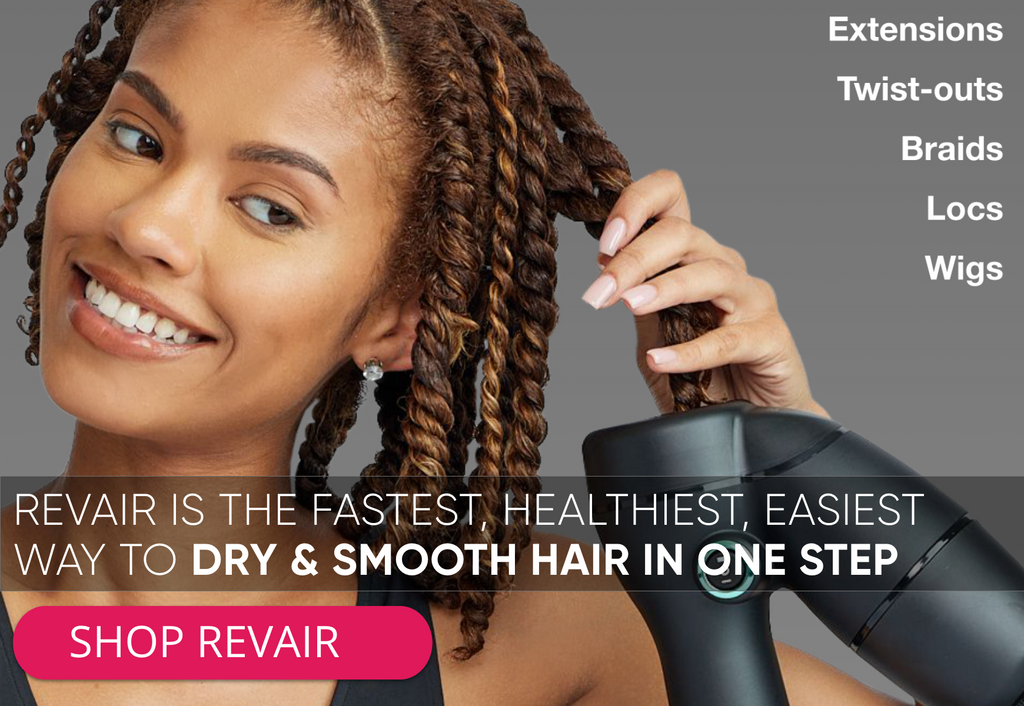
Trimming Your Natural Hair at Home - All You Need to Know

It's the norm for naturalistas to want to DIY their natural hair. From shampooing to conditioning and styling, we try to give it the best VIP treatment we can (after summoning energy from our whole lineage).
But there's one thing in particular that most of us usually either fear, forget or postpone until our natural hair starts begging for dear help. And that is...drum rolls please, trimming.
If you want to take the reins and make your tresses fabulous again, we have you covered. We will give you the ABCs of trimming type 3 or type 4 hair with confidence.
Why You May Want to Trim
Everyone's head of hair is unique, and there may be multiple factors that make you want to pick up your shears and get snipping.
You Have Split or Damaged Ends
Even after doing low manipulation styles for long periods, you still find that split ends always sneak their way back into your life. Our natural hair isn't invincible.
It might also have been damaged by chemical treatments, heat styling, and environmental factors like overexposure to the sun.
If you aren't sure whether it's damaged, check whether your strands:
- Are rough and crunchy
- Lack elasticity
- Snap easily
- Have single strand knots
- Tangle easily
- Have see-through ends
Your Styles are not Popping Anymore
You might notice that the bomb braid out which used to make heads turn doesn't look right anymore. It takes you more time to get it to look presentable, and the flyaway strands are unforgiving.
Your Layers are Starting to Grow Out
Our natural hair has a knack for growing at different rates, so the haircut you got last week might have started to fade away into the unknown. To keep it looking fresh, you might want to trim it back into shape.
Your Ends are Dry
When our ends stop responding to deep conditioning treatments, that's a sign that they need to go. They might feel dry and straw-like even after trying to smooth in all the moisturizers on our shelf.
You may want to let them go so you can focus your efforts on the remaining healthy hair.
Benefits of Trimming Your Hair

Gone are the days that most of us thought people trim their hair just because their stylist thought it would look cool or it would grow faster. While trimming doesn't increase factors like hair growth rate, it definitely has some pretty cool perks.
Hair Looks Fuller Afterwards
Straggly ends usually give the hair a see-through look at the bottom. On straight hair especially, it's easy to notice the thin spots which make it look dull and unhealthy. Doing away with the ends will make your hair look full from root to tip such that you won't even miss your Length.
It Annihilates Split Ends
Split ends are irreparable. Once a strand divides into two, the split end will continue to travel up till it reaches the root. Trimming will keep your natural hair healthy by preventing the split end from traveling.
It Makes Hair Easier to Manipulate
Trimming will get rid of those tangle-prone ends. You'll find that wash day becomes considerably more effortless, and your comb doesn't rip out hair with each pass - every natural's dream.
It's Free!
Do you usually cringe when someone comments on how being a natural must be cheap and easy?
Well, doing your own trim will save you a lot of money. A huge plus is that it'll make your styles look professionally done because you'll be doing them on healthier hair. Ladies and gents, it's time to make people think you walked right out of a hair magazine.
It Allows Your Hair to Grow Out
While trimming doesn't magically make hair grow faster, it creates an environment where your hair experiences the least tangles and fairy knots. Now your strands will break less often as they'll have no weak links and voila, you retain your inches.
How to Easily Trim Your Natural Hair at Home
There are various ways to have healthy ends again. Here are the popular and effective methods that we compiled.
Trimming Wet Hair
Type 3 and type 4 hair likes to curl and coil, a lot. You'll want to ensure it's thoroughly detangled before you begin your trim, lest you leave some knots unattended. Work in small sections for accuracy.
Comb out each section with your brush until it's smoothed out. As you comb, it'll be easy for you to feel the difference in your hair.
For instance, your damaged ends will feel rougher in comparison to your healthy hair. Be careful not to confuse your natural hair texture for damage.
You'll also be able to see where the ends start thinning out, and both these things will tell you where to cut. For each section, hold the hair taut just next to where you want to cut. Take your shears and snip off the ends, making sure not to injure yourself. Repeat for every section and you're done.
Trimming Wet Hair in Twists
Some naturals usually opt for this quick and straightforward process. Hop in the shower, cleanse your tresses, thoroughly detangle them in sections and twist up each section as you go like you would for a twist out.
If you look at the ends of your twists, it'll be easy to see where each curl starts struggling or looking limp. Take out your hair shears and snip each curl off at that point.
Trimming Curl by Curl
If you have a lot of time on your hands, you could decide to search and destroy your dead ends one by one. Only use this method if you know and have studied your curl pattern so it's easy for you to find the limp and straggly curls.
Have two mirrors, one for the front and another for the back, so you can clearly see what you're working with and how your hair is laying with each snip.
It will take patience and bravery to pull off this method but then again, that's what naturalistas are made of!
Trimming Stretched Hair
If you fancy wearing your hair in its stretched state a lot, then it's best if you consider straightening it pre-trim. This is because it's hard to conceal an uneven cut with stretched hair.
You could use our Reverse-Air Dryer to achieve the best stretch. If heat isn't your cup of tea, feel free to stretch your hair using twists, braids, or banding.
Then you could follow the procedure for trimming on wet hair. We also recommend type 4 naturals to trim their hair when stretched as it shrinks more than most when wet, making damaged ends hard to identify.
Dusting the Hair
Dusting is mostly for those of us who usually tend to get scissor happy. It entails trimming very small amounts of hair at a time such that it looks like you're taking off a layer of dust.
Simply section your hair in small sections and cut off the ends very lightly. To take it a step further, you can twist each section tightly together and snip off the hairs that jut out along the length of each twist.
Twist them in the opposite direction so you can get all the stragglers, and you're done. It's a super quick method.
Trimming Using the Ponytail Method
You will love this method if you like to see some layers in your hair. We recommend doing this on stretched hair to prevent it from shrinking as you make the cut.
First, hold it in a ponytail and position it according to how you want your layers to look. For shorter layers, have the ponytail closer to your forehead. The further back you push your ponytail, the longer the layers will look.
Once it's up, hold the hair in front of your face and use a hair tie to secure it at the point you want to trim. Take a pair of shears and snip.
Take your hair out and part it down the middle. Bring each side around to the front of your body, then snip evenly across the bottom hair layer. This will prevent your tresses from looking like there's a sharp V going down your back.
There are a few rules you should follow when doing on your trim so as to get the best results.
Do's and Don'ts of Hair Trimming
Don't Go Gaga with the Snipping
Trim each section of hair a little at a time. You can always snip off more, but you can't stick back what's already gone. Go slow if you're a beginner, and you'll see what your hair likes as time goes by.
Don't Use Dull Scissors
It's better to let your hair stay as it is instead of picking up those kitchen scissors you've been eyeing.
Using scissors that aren't specifically made for hair may damage your hair cuticles and leave you due for another trim sooner than you expect. To maintain your fabulous mane, get some hair shears that will snip snip snip to perfection!
Do Point Cut Your Ends
Point cutting your ends means holding your trimmed hair taut and cutting straight into the ends. Your shears will be parallel to your hair strands as you do this. This will help give a softer finish to your trim and make it look more professional.
Disadvantages of Trimming Your Natural Hair at Home
Like most processes, trimming hair at home also has its shortcomings. You might trim too much or too little, especially during your first few trims. Sometimes, you'll leave some damaged ends unattended, and other times, you'll get too excited and take too much off.
It may also be a while before you find a technique that gives your hair the right shape. After all, we still want to flaunt our glorious curls and coils.
As long as you remain positive and patient with your hair, as you have been so far, you'll eventually get the hang of it. Don't hesitate to contact us if you have any questions. All the best to you and your tresses - you got this!















